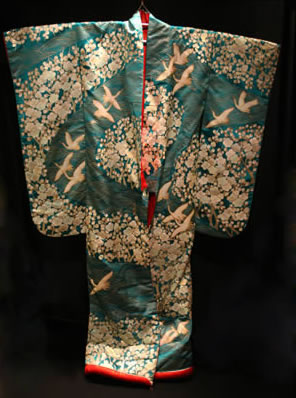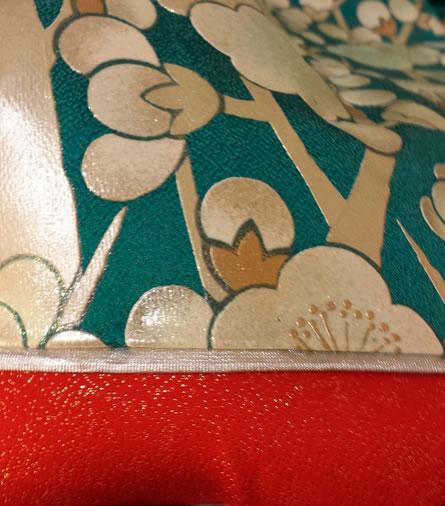The uchikake, a Japanese bridal kimono, seen in Figure 1 below dates from c.1980-2000. It is a rich blue-green color made from silk and lurex, and is elaborately decorated with images of cranes in flight over waves, and cherry blossoms.
Figure 1: Uchikate |
 |
In Japanese culture, nature is a recurring theme that is mimicked in the designs of kimono. The particular garment is adorned with cranes, blossoms, and the waves of a river of other body of water. The cranes appear to be flying over the water. Because cranes are a symbol of longevity they are an appropriate symbol for a bride to wear. The pattern meanders in an S-shape and creates curves on an otherwise very rectangular garment. As the cranes and cherry blossoms sweep across the garment reflections of light capture the viewer’s attention. The cranes and blossoms have bits of glitter within them which gives off an iridescence effect as colors of blue, pink and purple are reflected in the light, as seen in Figures 2 and 3 below. This creates a shimmering effect on the uchikake when it moves, adding to the drama of the garment. Also, each crane and blossom is outlined in the same gold color as the wave pattern, which adds to the dramatic effect of the garment.
Figure 2: Cherry Blossoms |
Figure 3: Cranes Flying Over Water |
 |
 |
Like most kimonos, the pattern in this uchikake is designed in a way that flows from one panel to the next without interruption, as seen in Figure 4 below.
Figure 4: Pattern over Seams |
 |
The drama and beauty of the garment continues on the interior of the uchikake with its startling bright red silk that lines the garment, as seen in Figure 5 below. The padded roll at the bottom edge of the garment is the same red silk, hemmed to the outside. As Figure 6 shows, metallic gold threads are woven throughout the red silk creating thousands of little specks the flicker in the light. The gold on the interior of the garment compliments the gold on the cranes, blossoms and waves on the exterior.
Figure 5: Interior |
Figure 6: Lining Detail |
 |
 |
On this modern uchikake modified techniques for dyeing and creating patterns have been used. The pattern on this uchikake was printed with synthetic textile paint. There is also some evidence of traditional embroidery on the uchikake in the calligraphy on the garment (see figure 11), but the cranes and blossoms are synthetic and printed or painted on.
Silver or gold foil embellishments were common on uchikake in the past. This uchikake maintains this the tradition through the use of the gold threads in the interior of lining. In addition, there is a strip of silver fabric over the top of the patted roll at the bottom of the garment, as seen in Figure 7. The gold and silver flakes of glitter on the blossoms and cranes is another way of maintaining this custom.
Figure 7: Padded RollAround Bottom Edge |
Figure 8: Calligraphy |
 |
 |
Dimensions
Most sources agree that the uchikake, has different dimensions than a standard kimono. Every kimono, including uchikake is made of rectangular panels. Standard ones measure between 36’ to 37’ long; a uchikake measures up to 59’ long.
The sleeves (sode) of the uchikake are 13” in width and 41 1/2" in length, much longer than the 25” of the standard kimono. The long sode add a dramatic effect to the uchikake. The sode-guchi, the opening for the hands, measure 8 1/2" in diameter.
Four panels that make up the central body of the kimono., The two panels in the front are called the mae-migoro and the back panels are called the ushiro-migoro. For a standard kimono, these panels have the same measurements of 4’ 9” in length and 12” in width However, for a uchikake, the mae-migoro and ushiro-migoro are still 12” in width but they are 5’10” in length. The additional length creates the fan-like train at the bottom of the garment.
The eri (long collar on either side of the garment) and the kake-eri (neck collar) form one continuous panel that extends from the neck to hem. The eri and the kake-eri are usually 1.8” wide on a standard kimono, but on the uchikake, the width is expanded to 4 1/2".
Finally, at the bottom of the kimono is the suso, a padded roll of fabric, made from the same red silk as the lining. It is padded with cotton batting which adds weight to the bottom of the uchikake and helps it to fan out, creating a beautiful silhouette.
Fiber
Lastly in addition to pattern, dyes, and construction, a final element that makes the uchikake unique is the fabric used. The garment is a beautiful blue-green color that has been achieved by printing patterns with synthetic dyes onto silk fabric. Silk has been used in Japan for thousands of years, and silk was used for many Japanese garments and coloring. The lining of this uchikake is red silk. The exterior of the garment is silk woven with lurex yarns to create the metallic finish of the garment. It is printed with synthetic textile paint and has a few embroidered details created with silk floss.
Damage
The textile paint used on the surface has become sticky with age.
© Dasmier Chambers Mason, 2014. Drama 475.001, Spring 2014 Semester. University of North Carolina at Chapel Hill.

